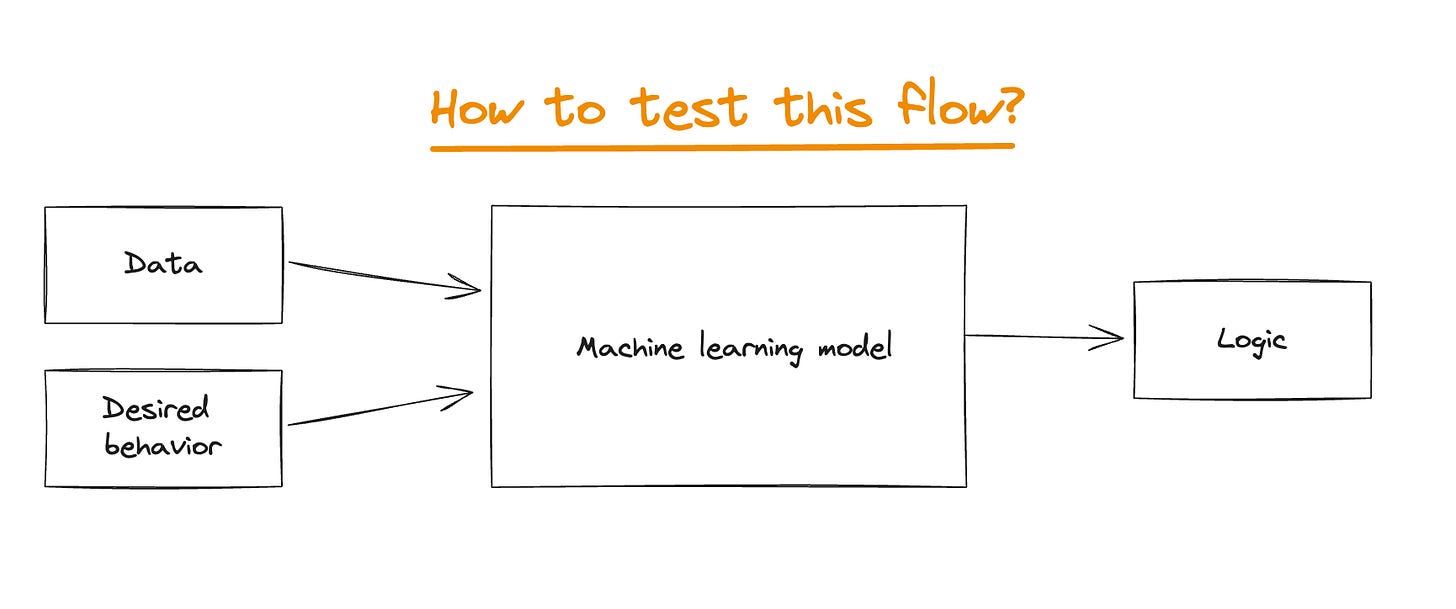44. Testing Machine Learning
How to actually test your machine learning models are doing what you expect them to do!?
Introduction
At this point, we all know about patterns for testing software: unit tests, end to end tests, roll out changes in different environment, etc.
But… how to test a “Machine Learning code”? The setup is wildly different:
In standard software, you have data and logic and you check you get the desired behavior.
In Machine learning, as the picture above shows, you have data and desired behaviour and check that the logic you expect is there.
In today’s article, we are going to learn how test your ML data flow from pretraining to model evaluation. Let’s get started!
Techniques
Pre-training tests
Pre-train tests allow you to identify some bugs early on before spending $$$ on those GPU cycles ;).
Many tests can be run without needing trained parameters:
Check the shape of your model output and ensure it aligns with the labels in your dataset
Check the output ranges and ensure it aligns with the expectations
Make sure a single gradient step on a batch of data yields a decrease in loss
Make assertions on your dataset
Check for label leakage between your training and validation datasets
Loss function: calculate by hand a loss and create a unit test
Check that trainer logs steps
Test that the model can overfit on a single batch of data
Sample independence: batch training assumes that the model can process each sample iid! That is, samples in the batch don’t influence each other in the training step. This is very brittle, as you can easily make a mistake with a misplaced reshape / aggregation. How to test: forward pass and backward pass, but before averaging the loss over the batch multiply one loss by 0. This will result in a gradient of 0 given the model upholds sample independence, then the test should just assert that the samples gradient is 0.
Post-training tests
How to ensure that the learned logic makes sense?
After training a model, you will typically produce an evaluation report that includes:
Performance of an established metric on a validation dataset
Plots such as precision recall curves
Operational statistics such as inference speed
Examples were the model was most confidently incorrect
You should also follow classical conventions such as:
Save all of the hyper-params used to train the model
Only promote models which offer an improvement over the existing baseline
Post training tests should interrogate the logic learned during training.
Invariance tests allow to describe set of perturbations to make to the input without affecting the model’s output. Then, you can check for consistency in the model predictions.
Minimum functionality tests aim to quantify model performance for specific cases found in the data, which allows you to identify critical scenarios where prediction errors lead to catastrophic consequences.
Model testing vs Model evaluation
In a nutshell:
Model evaluation covers metrics and plots which summarize performance on a validation or test dataset.
Model testing involves explicit checks for behaviors that we expect our model to follow.
Both of these perspectives are instrumental in building high-quality models.
In practice, most people are doing a combination of the two where evaluation metrics are calculated automatically and some level of model "testing" is done manually through error analysis (i.e. classifying failure modes).
However, this does not help uncover possible regression on critical subset of data of high importance.
Conclusions
I hope you will employ the techniques showed above to improve the health of your systems. I believe that setting up an evaluation/testing framework for your model can pay back dividends when you find out *that* training bug that very subtly messes with your model.
Happy machine learning testing!
Ludo



Hello, thank you for this amazing article! Can you please explain better why we need to make sure that a single gradient step on a batch of data yields a decrease in loss? The loss can usually go up and down at each training step (hopefully more times down than up), and it does not look like a strictly decreasing function. Let me know if I am missing something.